Fate of SCE&G’s Horribly Mismanaged V.C. Summer Nuclear Reactor Construction Project in South Carolina to be Revealed on Monday, July 31, 2017!
SPECIAL CALLED MEETING OF THE
SANTEE COOPER BOARD OF DIRECTORS
NELSON, MULLINS, RILEY AND SCARBOROUGH
MERIDIAN BUILDING, 17TH FLOOR
1320 MAIN STREET
COLUMBIA, SOUTH CAROLINA
Monday, July 31, 2017 – 10:00 a.m.
Board to vote on “Resolution: VC Summer Authorization – Authority Action Regarding New Nuclear Project” and we assume that the SCANA (parent of SCE&G) will have acted by the time the Santee Cooper board acts. Look for a joint news release around 11 a.m. on Monday, July 31.
The smart bet is on abandonment or building just one unit. In any event, Friends of the Earth & the Sierra Club will pursue clawing back money for ratepayers and holding SCE&G and Santee Cooper accountable.
Article in The State, Columbia, SC, July 29 print edition:
“Walk away or build it? Decision on SC’s troubled nuclear reactor project nears”
http://www.thestate.com/news/local/article164227067.html
&
The Nerve, Columbia, SC, July 20, 2017
“Why is electricity so expensive in South Carolina?”
Hint: Has something to do with the bungled nuclear project and that ratepayers are forced by SCE&G to pay in advance for it under the unjust Baseload Review Act.
—–
South Carolina Nuclear Reactor Construction Project Circling the Drain? Not enough $ in this deal to save SCE&G’s nuclear reactor boondoggle:
Markets aren’t buying the deal – SCANA stock plummeting – down 6.67% as of 12:36 p.m. EDT on July 28 – it might rebound but so far is this the worst day in company history? (see stock price here)
“Santee Cooper, SCE&G to accept nearly $2.2 billion from Toshiba for nuclear plant”
The State, July 28, 2017, front page in print edition, article linked here
The mood was almost somber in the Santee Cooper board room on July 27 when the deal with Toshiba was announced. Payment of $2.2 billion to SCE&G and Santee Cooper from beleaguered Toshiba, if payment actually occurs, will not be enough to save the problem-plagued reactor construction project. Now, for the first time, SCE&G and Santee Cooper admit that the reactors won’t be finished in 2020, something they have been studiously avoiding saying until now. The “Vow of Silence” by the project owners, S.C. Office of Regulatory Staff and the Electric Cooperatives of South Carolina is crumbling at their feet. They will be held accountable for allowing this situation to develop, to continue without proper review and to unjustly be foisted on ratepayers.
See SCE&G/Santee Cooper documents released on July 27:
SCE&G/Santee Cooper news release – linked here
V. C. SUMMER AUTHORIZATION ON TOSHIBA GUARANTY SETTLEMENT –
linked here
Statement by J. Michael Baxley, Senior VP and General Counsel
Meeting of the Santee Cooper Board of Directors, July 27, 2017 on
TERMS OF THE TOSHIBA GUARANTY SETTLEMENT – linked here
—–
Why is Secretary of Energy Perry getting involved in matters related to the Affordable Care Act when that’s not DOE business and when urgent things such as SRS clean-up are pressing?
The House Energy and Commerce Committee has asked the Government Accountability Office (GAO) to look into this.
July 26, 2017 letter to GAO linked here
—–
Trump/White House statement on DOE appropriations by US House – affirms opposition to MOX boondoggle at SRS, July 24, 2017
“Mixed Oxide (MOX) Fuel Fabrication Facility Termination. The Administration strongly objects to continued construction of the Mixed Oxide (MOX) Fuel Fabrication Facility as directed in the bill. The project is unaffordable and risky. The most recent estimates, conducted by the Department of Energy and the Corps of Engineers, project $12 billion in remaining construction costs, and total construction costs of $17 billion when including $5 billion in sunk costs to date. In addition, the projected operating costs are between $800 million and $1 billion per year for nearly two decades. The alternative—dilute and dispose—is a proven approach with significantly less risk and expense, and can be implemented decades sooner than the MOX approach.”
statement on appropriations legislation linked here
—–
July 25, 2017: SRS CAB Votes “No” to High-Level Nuclear Waste Consolidation at SRS
SRS Citizens Advisory Board (SRS CAB) voted 16-6-1 against the consolidation of spent fuel and high-level nuclear waste managed by DOE’s Office of Environmental Management (EM) from being consolidated at SRS. The subtext of the recommendation, to be sent to DOE, is also against consolidation of commercial spent fuel at SRS. the recommendation should be posted on the SRS CAB website in a few days: http://www.srs.gov/general/outreach/srs-cab/recommendations_2017.html
—–
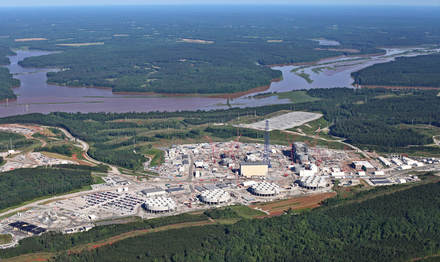
Is SCE&G poised to make a big announcement about the fate of its mismanaged VC Summer rector project? Well, no…..
see July 25 letter from SCE&G to SC PSC – linked here
article in Charleston (South Carolina) Post & Courier, July 25, 2017:
“SCE&G reschedules regulatory meeting about troubled nuclear project, raising fresh questions about its future ”
article linked here
The pieces of the puzzle needed to go ahead with the project are not completed. The longer the project is delayed and no cost estimate or schedule is produced the more abandonment is likely in our opinion.
A $1.7 billion “guarantee” from Toshiba is not enough to save the project give the billions of dollars in looming cost overruns, billions that shareholders may well have to pick up. That “agreement” is to be discussed by Santee Cooper, the 45% partner, at a special telephone board meeting on July 27 – see the agenda here. And the Toshiba agreement will likely be discussed by SCE&G at the briefing on August 1 but this won’t save the bugled project.
Photo: VC Summer, May 26, 2017, ©High Flyer
—–

1. June 22: Friends of the Earth/Sierra Club files with s.C. Public Service Commission for a hearing to get to the bottom of how the debacle was caused, who must be held accountable, to halt unauthorized spending on the project ($120 million/month) and to seek monetary “reparations” for the victims – “complaint” linked here;
2. July 6: PSC immediately agrees to FOE/Sierra Club request and sets hearing for August 14, due to schedule conflicts, hearing is rescheduled to October 2 – hearing officer “directive” linked here;
3. July 9: FOE/Sierra Club lawyer files first request for documents relevant to the hearing, as allowed by law and regulation – linked here;
4. July 20: SCE&G howls in protest at the mere thought of having to answer probing questions in an on-the-record hearing and files document with PSC opposing hearing and document request – “Motion to Dismiss” linked here & “answer” linked here
July 21: FOE/Sierra Club lawyer files document against SCE&G request against a hearing on the construction disaster of their own making –
linked here.
As SCE&G is being allowed over 10% return on the project, including massive cost overruns, and given excess capacity and erroneous load forecasts, we must ask if this project was to produce electricity or is it really TO MAKE MONEY?!
Stay tuned developments as inept SCE&G will continue to seek to dodge accountability and try to place massive cost overruns on the backs of ratepayers. Friends of the Earth and the Sierra Club will strive to protect the public interest and make sure that SCE&G and its shareholders are finally required to put some skin in this sad game.
—–
Statehouse Report, Columbia, South Carolina, July 21, 2017
Lawmakers nonprofits seek remedy for stalled nuclear construction
South Carolina ranks number 1 in the country for electricity costs! And, it’s going to get worse due to the bungled construction of two experimental AP1000 reactors.
See WalletHub, July 12, 2017:
https://wallethub.com/edu/energy-costs-by-state/4833/
—–

The exodus of MOX workers, who apparently see the handwriting on the wall, appears to be speeding up. If our take is wrong, let us know: srswatch@gmail.com
While the MOX project is winding down to termination at a snail’s pace, looks like the exodus of workers from the MOX boondoggle is moving at a jack-rabbit speed. These CB&I AREVA MOX Services listings were posted on one job advertisement site on July 20, 2017 – the most postings, by far, that we’ve seen on a single day:
IT Helpdesk Customer Support Tech 1 or 2
Costpoint Business Analyst 2 or 3
IT Helpdesk Customer Support Tech 1
Project Controls – Quantity Surveying (Cost Specialist I)
Civil/Structural Rigging CFE 3 or 4
Mechanical Test Technician – CFE2
Mechanical Construction Field Engineer 1 or 2
Project Controls Scheduling Specialist I
Civil Planner (Constr. Tech Services Specialist)
Piping Engineer III to Sr Piping Engineer 1
Rigging Site Superintendent 2 or 3
Construction Technical Services Manager 1-2
Electrical Planner (Const Tech Services Spec)
Electrical & Instrumentation Test Manager
Mechanical/Piping Planner (Const Tech Serv Spec II or III)
HVAC Construction Field Engineer 4
Sr. Structural Engineer
See more MOX jobs, linked via the website of CB&I AREVA MOX Services, LLC: https://www.moxproject.com/careers.html
—–

SRS Watch in “Plutonium oxide shipments to SRS on hold”
Aiken (South Carolina) standard, July 20, 2017
image: Senator Lindsey “MOXie” Graham the valiant MOX Cowboy, rides again!
—-

It appears that MOX termination nears
Chairman Lamar Alexander Opening Statement
Committee on Appropriations Subcommittee on Energy and Water Development
Markup of the FY2018 Energy and Water Development Appropriations Bill
July 18, 2017
“We also continue to be very concerned about the cost of the MOX Fuel Fabrication Facility in South Carolina, and we agree with the recommendation in the budget request to terminate the program. We are working with Senator Graham and the Senate Armed Services Committee to find a path forward to move plutonium out of South Carolina sooner and at a lower cost to taxpayers”
Soon, all that will be left of MOX is the last squeals…..
—–
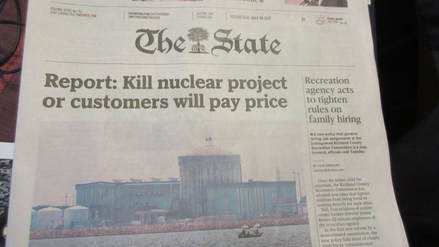
July 18, 2017: Friends of the Earth/Sierra Club release report on failed nuclear reactor project, by economist Dr. Mark Cooper
“THE FAILURE OF THE NUCLEAR GAMBLE IN SOUTH CAROLINA”
Regulators can Save Consumers Billions by Pulling the Plug on Summer 2 & 3, Already Years behind Schedule and Billions Over Budget;Things are Likely to Get Much Worse If the Project Continues
News release, with link to report summary & Docket 2017-207-E: “Report Calls for Abandoning Bungled Nuclear Project in South Carolina” – linked here
articles on FOE/Sierra Club press event, from July 18, 2017:
Associated Press, in Charleston (SC) Post and Courier:
“Report urges end of nuclear power project in South Carolina”
& The State, Columbia, South Carolina – photo of front page on July 19, 2017 is above
“Economist predicts spike in power bills if SCE&G nuke project moves ahead”
Charleston (South Carolina) Post & Courier, July 20, 2017
“SCE&G moves to throw out environmentalists’ effort to halt construction on troubled nuclear project”
linked here
—–
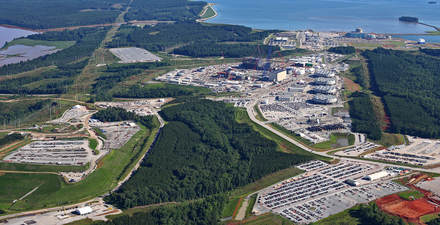
Friends of the Earth and Sierra Club Tele-News Conference, Report Release: “Failed Economics of South Carolina’s Nuclear Reactor Construction”
Nuclear Economics Expert Documents How Project Failed and Calls on Officials to Abandon V.C. Summer Nuclear Project on 11AM Telepress Conference Call, Tuesday, July 18, 2017
COLUMBIA, S.C. – Friends of the Earth and the Sierra Club on Tuesday, July 18 will release an in-depth analysis in advance of a hearing before the South Carolina Public Service Commission on the troubled nuclear reactor construction project by South Carolina Electric and Gas (SCE&G). The report, entitled The Failure of the Nuclear Gamble in South Carolina, will be presented by economist Dr. Mark Cooper, who will make the case that the project must be abandoned and that ratepayers should be issued refunds due to imprudence on the part of SCE&G. Over $9 billion has been sunk into construction of the two Westinghouse AP1000 reactors and the project remains without a cost estimate or construction schedule. With construction only 37% complete and delays mounting, unauthorized spending continues at the rate of $120 million per month and the overall cost appears to be nearing $20
>>> details in July 14 media advisory on FOE website, under news, advance registration required; advisory here: https://tinyurl.com/ybbchu3b
photo: SCE&G’s VC Summer site, May 26, 2017, ©High Flyer
South Carolina AARA has filed a letter with the South Carolina Public Service Commission – in Docket 2017-207-E – in support of the complaint filed on June 22, 2017 by Friends of the Earth/Sierra Club on SCE&G’s nuclear reactor debacle – see July 12, 2017 AARP letter here, posted in the docket on July 14, 2017
—–
1. 9975 Shipping Package Component Long-Term Degradation Rates – Savannah River National Lab, June 2017 – linked here
9975 containers hold inner 3016 cans of plutonium stored in the old K-Reactor at SRS; those cans hold almost 13 metric tons of plutonium so the long-term status of the containers is a safety issue.
“Special nuclear materials are being stored in the K-Area Complex using 3013 containers that are held within Model 9975 shipping packages. The service life for these packages in storage was recently increased from 15 to 20 years, since some of these packages have been stored for nearly 15 years. A strategy is also being developed whereby such storage might be extended beyond 20 years. This strategy is based on recent calculations that support acceptable 9975 package performance for 20 years with internal heat loads up to 19 watts, and identifies a lower heat load limit for which the package components should degrade at half the bounding rate or less, thus doubling the effective storage life for these lower wattage packages. The components of the 9975 package that are sensitive to aging under storage conditions are the fiberboard overpack and the O-ring seals, although some degradation of the lead shield and outer drum are also possible.”
2. Thermal Evaluations for Hypothetically Drain-Down Spent Fuel Storage Facility at SRS, Savannah River National Lab, December 2016, linked here
Is there risk of a spent fuel fire or radiation release if all the water is lost from the L-Basin (where research and medical isotope spent fuel is stored at SRS)? How long will this 63-year-old pool be used to receive domestic and international spent fuel shipments?
“RESULTS AND SUMMARY
Three-dimensional steady-state CFD models were developed for thermal performance evaluations of the SNF temperatures when all water in L-Basin storage pool was completely drained away in the case of a hypothetical accident. The modeling calculations were performed, assuming that the storage racks are fully loaded with SNF assemblies containing a series of different decay heat sources. The model was
benchmarked against the theoretical results and literature
data. Based on the verified model, several sensitivity
calculations with respect to nominal operating case were
performed.
The calculation results show that when SNF fuels are fully loaded with uniform decay heats of 250W VTS bundle and 400W HFIR core, maximum SNF temperature reaches 282oC (540oF) in the case of a
hypothetical drain-down accident. The temperature distributions for the VTS and HFIR racks are presented in Figures 1 and 2. The conservative results demonstrate that the maximum SNF temperature does not exceed a temperature limit 400oC (752oF) in the case of
hypothetically dry storage conditions.”
—–
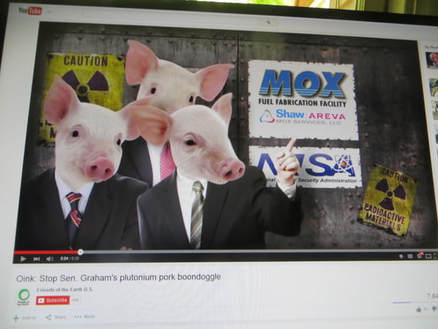
The U.S. Senate Armed Services Committee has acted on the National Defense Authorization Act for Fiscal Year 2018. The committee has “authorized” (not appropriated) an increase in spending on the MOX boondoggle. Like the House Armed Services Committee, the Senate legislation would allow the Secretary of Energy to follow through on the Trump administration’s goal to terminate the MOX boondoggle if certain achievable conditions are met.
U.S. Senate – NATIONAL DEFENSE AUTHORIZATION ACT FOR FISCAL YEAR 2018 – Report – July 10, 201 – linked here
“Use of funds for construction and project support activities
relating to MOX facility (sec. 3112)” – page 351:
“The committee recommends a provision that would require the
Secretary of Energy to carry out construction and project support
activities for the Mixed Oxide Fuel Fabrication Facility (MFFF)
with any funds authorized to be appropriated or otherwise made
available for such purposes for fiscal year 2018.
The Secretary may waive this requirement to carry out construction
and project support activities related to the MFFF project if
the Secretary submits to the congressional defense committees: (1)
The commitment of the Secretary to remove plutonium intended to
be disposed of in the MOX facility from South Carolina and ensure
a sustainable future for the Savannah River Site and (2) Certification
that an alternative option exists for carrying out the plutonium
disposition program for the same amount of plutonium identified
that was to be disposed of in the MOX facility is completed
meeting the requirements of National Nuclear Security Administration
Business Operating Procedure ‘‘BOP–03.07, Analysis of Alternatives’’
dated March 14, 2016; details of any required statutory
or regulatory changes to complete the alternative option, and that
the total lifecycle cost, consistent with Government Accountability
Office cost estimating and assessment best practices as found in
GAO–09–3SP ‘‘GAO Cost Estimating and Assessment Guide,’’ that
the alternative option would be less than half of the estimated remaining lifecycle cost of the mixed-oxide fuel program, estimates
that should be of comparable accuracy.”
Other MOX-related discussions of interest on pages 354, 355 and 357 in Senate NDAA report, linked here
Image above – from Friends of the Earth video on the MOX pork-barrel debacle, 2013, Oink! – video linked here: https://www.youtube.com/watch?v=d2PTwods3Y4
—–
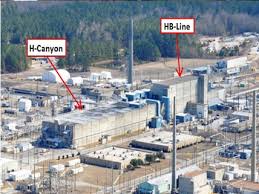
Recalling the recent collapse of a tunnel containing radioactive material at DOE’s Hanford site, we ask: Why isn’t DOE releasing this information and updating the public about a matter that could hold safety consequences?
DNFSB weekly report, June 26, 2017 (released July 12, 2017)
TO: S. A. Stokes, Technical Director
FROM: M. T. Sautman and Z. C. McCabe, Resident Inspectors
SUBJECT: Savannah River Site Resident Inspector Report for Week Ending June 16, 2017
“H-Canyon Exhaust (HCAEX) Tunnel: A review of the recent HCAEX Tunnel crawler inspection video revealed that a 180 feet long section of the HCAEX Tunnel had significantly more exposed reinforcement bar (rebar) than previously known and considered in the structural analysis. SRNS personnel subsequently declared a potential inadequacy in the safety analysis (PISA) because the ability of the HCAEX Tunnel to perform its safety class function is indeterminate. SRNS engineers are currently revising the structural analysis calculation to determine if the HCAEX Tunnel will be able to perform its safety function. SRNS expects the revision to conclude that the tunnel can perform its safety function and therefore determined no compensatory measures are required at this time. The amount of concrete that has degraded, fallen, and built up on the floor of the HCAEX tunnel appears to be unchanged between the two most recent videos. Additionally, the most recent inspection incorporated some lessons learned from previous inspections that led to better picture quality. Therefore, SRNS personnel believe that the additional exposed rebar is not newly exposed from recent degradation but rather only newly seen and likely has been there for some time. However, if this is newly exposed rebar it may be difficult to discern a difference in the concrete debris on the tunnel floor between the two most recent videos if only a small amount of concrete cover was remaining before it degraded.”
DNFSB weeky report, June 16, 2017 – released on July 12, 2017 – linked here
—–
South Carolina Office of Regulatory Staff (ORS) posts update on the status of the Westinghouse bankruptcy, as it impacts the bungled South Carolina Electric & Gas (SCE&G) nuclear reactor construction project, July 12, 2017
Devastating confirmation: ORS update reveals that 8 years after the approval by the SC Public Service Commission to begin reactor construction that there is still NO construction schedule and NO cost estimate
“SCE&G and Santee Cooper, as the owners of the V.C. Summer Plant (the “SC Owners”), continue in their analysis and assessment of whether to complete or abandon the Plant, or to complete one reactor but abandon the second new reactor at the Plant, or to pursue some other, as of yet undetermined, course of action. The SC Owners have not reached an agreement with Westinghouse regarding its engineering, procurement and construction contracts (collectively, the “EPC Contract”) for the V.C. Summer Plant, and they have not yet reached an agreement with Toshiba resolving Toshiba’s liability on its guaranty to them.”
Note this interesting bit in the ORS update: “An issue may exist in the Westinghouse bankruptcy regarding an audit of or investigation of Westinghouse and its transactions with affiliates and third parties. The matter has been raised in the context of Westinghouse’s application to employ special counsel to represent the “U.S. AP1000 Committee” (the “Special Committee”) of the Westinghouse Board of Directors.”
—–
July 12, 2017 – SCE&G wants to discuss the bungled VC Summer nuclear reactor project with the South Carolina Public Service Commission without being subject to questioning by intervenors. Could the request below be a feeble answer to the hearing request by Friends of the earth & the Sierra Club? that hearing, in respond to a complaint filed on June 22, is now scheduled for October 2.
“South Carolina Electric & Gas Company – Request for Allowable Ex Parte Briefing to Discuss Updates Regarding the New Nuclear Units at V.C. Summer Nuclear Station and Status of the Contractor, Westinghouse Electric Company, LLC –
Commission Directive – Agenda Item #21 – Staff Presents for Commission Consideration a Request for South Carolina Electric & Gas Company to Provide an Allowable Ex Parte Briefing Related to V.C. Summer Units 2 and 3″
Docket-ND-2017-12-E linked here
No date yet set for the briefing.
—–

What else could they do as the mismanaged MOX project is not financially or technically viable and nobody has made any sort of case that it is? We note the silence of Senator Lindsey Graham and Representative Joe Wilson as their pet boondoggle circles the drain. Are they on a MOX death watch?
White House news release, July 11, 2017 on:
“H.R. 2810 – National Defense Authorization Act for Fiscal Year 2018”
“Mixed Oxide (MOX) Fuel Fabrication Facility: The Administration strongly objects to section 3119 directing construction of the Mixed Oxide (MOX) Fuel Fabrication Facility. The Administration appreciates the flexibility provided to the Secretary of Energy to waive that requirement and terminate the MOX project. The MOX project is unaffordable and risky, with $12 billion in remaining construction costs, based on the most recent estimate prepared in collaboration with the Army Corps of Engineers and the Department of Energy. The project would bring total construction costs to $17 billion, when including $5 billion in sunk-costs to date. In addition, the projected operating costs are between $800 million and $1 billion per year for nearly two decades. The Administration supports the Committee’s recommendation to authorize funds for the Savannah River Site’s (SRS) dilute and dispose capability to remove from South Carolina, and dispose of, surplus plutonium stored at SRS. Dilute and dispose is a proven approach with significantly less risk and expense, and it can be implemented decades sooner than the MOX approach.”
—–

“Documents favor MOX over downblending”
Aiken (South Carolina) Standard, July 11, 2017
—–

“Los Alamos disciplines employees for lapses”
Albuquerque (New Mexico) Journal, July 10, 2017, article linked here
“Federal officials announced June 23 that LANL had disclosed that “special nuclear materials” – a category that includes plutonium and enriched uranium – had been shipped from LANL by air to national labs in California and South Carolina in violation of regulations. National Nuclear Security Administration Administrator Frank Klotz called the error “absolutely unacceptable.”
DOE photo of containers to store larger amount of plutonium: “There are three configurations of the “convenience can” used for storing plutonium oxide and other excess plutonium metal. These three configurations…”
—–
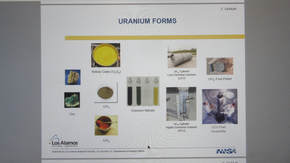
Safeguarding the Nuclear Fuel Cycle: Mining, Milling, and Conversion
Uranium Enrichment Safeguards
—–